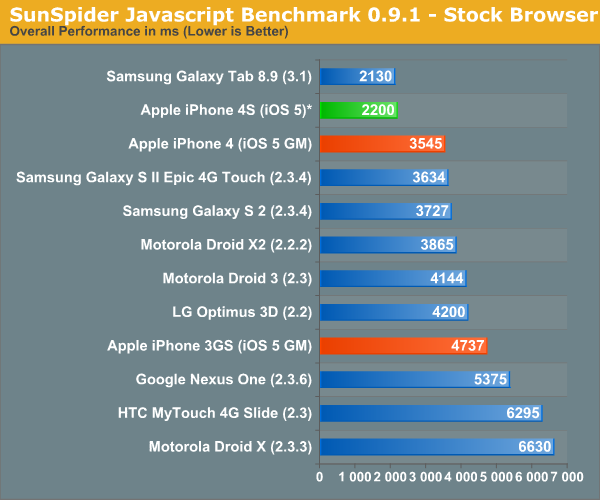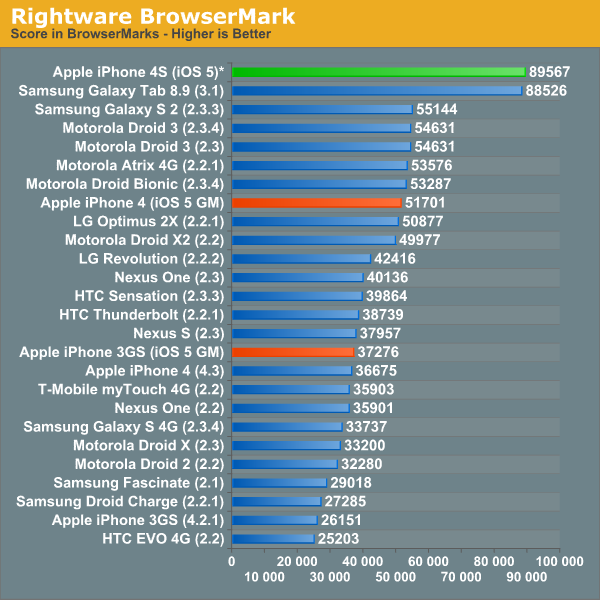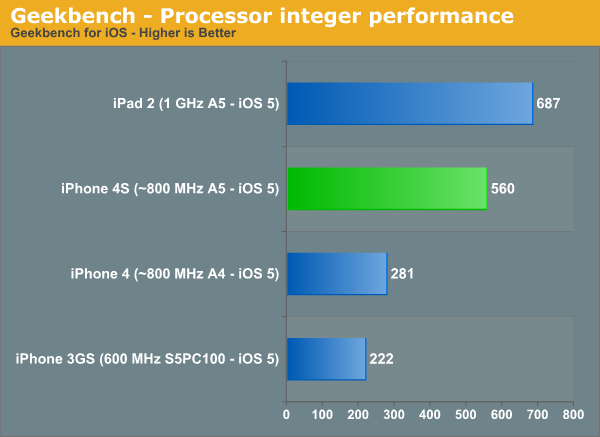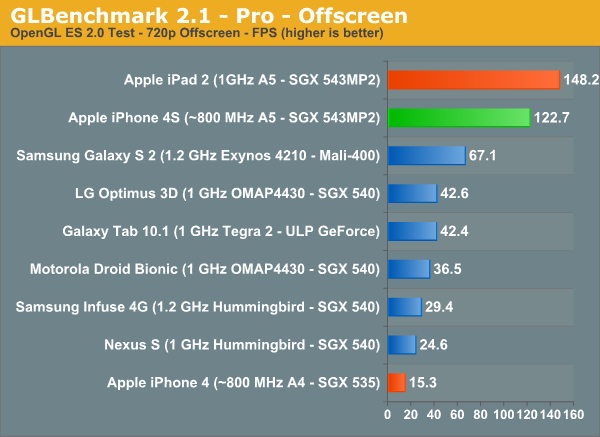iPhone 4S Preliminary Benchmarks: ~800MHz A5, Slightly Slower GPU than iPad 2, Still Very Fast
by Anand Lal Shimpi & Brian Klug on October 11, 2011 3:22 AM EST- Posted in
- Smartphones
- Apple
- Mobile
- iPhone 4S
- SoCs
Apple's ability to control the entire information chain, down to the point of limiting leaks, appears to be gradually slipping as it grows as a company. Case in point are the numerous hardware and performance leaks surrounding the newly launched iPhone 4S. Little did we know that several weeks ago we were staring at photos of the 4S' PCB, and more recently we've seen the first performance results from Apple's first A5 based smartphone thanks to a few eager users around the web. We've compiled these results here from various sources (all linked below) and compared them to our existing database of tests.
The results are pretty much as expected. Javascript performance finally catches up to Tegra 2 based Honeycomb devices, while general CPU performance is significantly higher than the iPhone 4. I suspect Ice Cream Sandwich will bridge the Android smartphone gap (the Honeycomb equipped Gtab 8.9 is here to give you an idea of where a more modern Android browser ends up).
Keep in mind that all of these tests measure performance of the software stack in addition to the hardware. In particular the web browser tests depend largely on browser optimizations, which is why we see differences between similar hardware running different browser versions. Also note that all results were run at stock, with the stock browser. Finally, although these browser tests were captured on video we'll still be running our official tests once our 4Ses arrive and will update accordingly.


Using some of the integer and fp tests of published Geekbench scores we can already conclude that Apple is shipping a lower clocked A5 in the iPhone 4S than it does in the iPad 2. This naturally makes sense as the iPhone 4S has a much smaller 5.25 Whr battery. Based on the Geekbench results it looks like the iPad 2 is clocked around 25% higher than the iPhone 4S, pegging the latter's clock speed at 800MHz.


A lower clock not only means higher yields from the factory, but likely a lower operating voltage as well. Dropping a CPU's core voltage, yields a greater-than-linear decrease in power consumption, making the marginal loss in clock speed a good choice. At a lower operating frequency than its Android competitors, Apple does have to exploit its strengths in software to avoid any tangible performance penalties. Apple has traditionally done this very well in the past, so I don't expect the loss of frequency to be a huge deal to the few who do cross-shop iOS and Android.
Unsurprisingly, memory bandwidth doesn't appear to have gone up either compared to the iPad 2's A5 (taking into account scaling due to CPU clock increases). The Samsung part number on the iPad 2's A5 indicates two LPDDR2-800 die on package, it's safe to assume that whatever Apple clocked the memory interface at in the iPad 2 remains unchanged in the iPhone 4S.
The GPU results tell a similar story courtesy of some early GLBenchmark 2.1 results. The 960 x 640 results are useless as they are bound by vsync at ~60 fps. Luckly GLBenchmark 2.1 added an off-screen render mode at 1280 x 720 where we can really see the differences between the iPad 2 and iPhone 4S A5 implementations:


Here the iPad 2 holds a ~21% performance advantage, which once again I assume to be all related to clock speed. Also note the huge advantage over the existing iPhone 4. The GPU power in the 4S should be more than enough to run any well written, current generation title at well north of 30 fps on its display.
We'll be reviewing the iPhone 4S in the coming weeks, stay tuned!
Source: GLBenchmark Database, Geekbench Database, Macrumors










216 Comments
View All Comments
WaltFrench - Tuesday, October 11, 2011 - link
Obviously, a lot of the commenters here have already sent off their check for future devices that will have ICS Real Soon Now.Many of these same commenters also have a guarantee that AT&T or Verizon or whoever will NOT lock down these new devices, or otherwise make it difficult to install non-standard ROMs.
Perhaps you missed the *guarantees* that the 3rd party browsers will exploit all the extra CPU and GPU power in their future releases, which will be ready on the day this new hardware/OS ships.
And all these new models, upgrades and patches will be ready for YEARS before the Fruit Company releases its next models.
Open always wins!
KoolAidMan1 - Thursday, October 13, 2011 - link
You win best post.It is hilarious how much spin and excuses are going on here, holy crap...
Shadowmaster625 - Tuesday, October 11, 2011 - link
So how long does the battery last playing Infinity Blade?tipoo - Tuesday, October 11, 2011 - link
Good question. They said the battery was improved in almost every metric (standby time is down to 200h from 300 for some reason), but that might change when both cores and the GPU are maxed.webdev511 - Tuesday, October 11, 2011 - link
It would be pretty embarasing if you did have one in the mix (like the HTC Titan) and it beat the snot out of everyone.Repost this story when you decided to include more than just the mono-culture and the fragemented platforms.
cioxx - Tuesday, October 11, 2011 - link
Apple controls the entire stack and can optimize like crazy on top of having faster hardware. Android ODMs don't have that option despite the fact they have access to the source. It's like shooting a fast moving target while juggling bunch of components.These results are insane. iPhone 4S smokes the Samsung flagship phone and holds its own against the tablet. I hope the developers don't treat this as baseline.
morphon - Tuesday, October 11, 2011 - link
Multi-core browser vs. single-core browser.Opera Mobile on any of the Android superphones (anything dual-core) will put up the same numbers as the iPhone 4S in browser benchmarks. My 8 month old G2X does, and it isn't as fast as the new Samsung.
But it's what you'd expect. The ARM cores inside the A5 are not significantly faster than the cores in a Tegra2 or Exynos. The Android phones are running at a higher clock speed as well.
Imagine two machines - one running OSX with the latest Safari, the other with Windows and IE. The Safari box will probably win. But does anyone who cares about performance run IE? No, they probably run Chrome or Opera. Use one of those and the Windows machine, seemingly by magic, will match or exceed the OSX box. Same hardware. Similarly optimized OS's. Highly optimized browsers.
The important part of the A5 is the GPU. I think everyone would like to see more data on that.
doobydoo - Sunday, October 16, 2011 - link
Again, if you want to compare non-stock, you have to do it on both sides. Taking 1 stock vs 1 non stock is.. desperate, to say the least.The GPU performance speaks for itself. The iPhone 4S is by far the fastest phone on the market.
tomhoward - Tuesday, October 11, 2011 - link
On my SGS2 I'm getting 1561ms as the browser benchmark, what software version is the one tested here?Screenshot - http://postimage.org/image/21rbk83hg/
xdoylex26 - Tuesday, October 11, 2011 - link
I just honestly couldn't believe these benchmarks, so I went ahead and tested them out myself for verification on my GS2 w/ 2.3.4 on AT&T.SunSpider 9.1 w/ firefox beta = 1412.9 ms
Given it's not the stock browser, but why does that matter when your comparing graphical benchmarks on a a screen resolution higher than your device?
Move along people, nothing to see here.